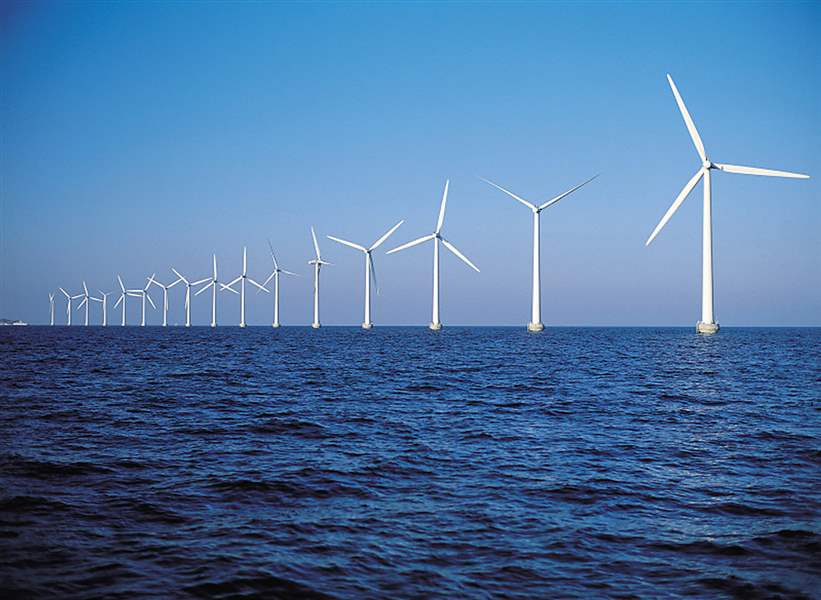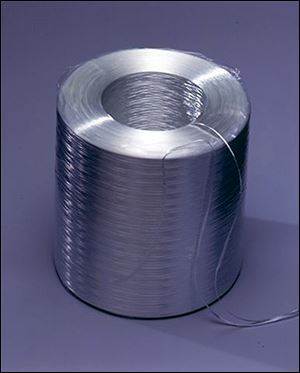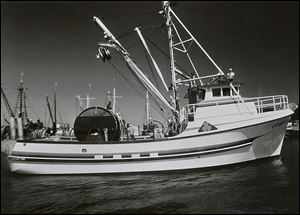
OWENS CORNING: A TOLEDO MAINSTAY FOR 75 YEARS
Owens Corning composite materials found in countless products
10/26/2013
WindStrand, an Owens Corning product, has been used to make the blades for this wind farm near Copenhagen.

WindStrand, an Owens Corning product, has been used to make the blades for this wind farm near Copenhagen.
The Boeing Dreamliner, the newest jet from the world’s largest airplane manufacturer, soars miles above the Earth with a 60-meter wingspan.
That’s the same length as a single blade on many commercial wind turbines. Though the properties of a jetliner wing and a windmill blade aren’t quite the same, it’s an apt size comparison that helps to show just how massive utility-scale wind turbines really are.
John Hillenbrand says the blades couldn’t be so large without the use of composite materials.
“Getting to that 50, 60-plus meters of blade, only composites can deliver that combination of lightweight strength and stiffness,” he said.
Specifically, Mr. Hillenbrand is talking about fiber glass. As the chief innovation officer for Owens Corning, he knows a thing or two about the possibilities contained within the tiny glass fibers.
They’re nearly endless.
It was Owens Corning that, by happy accident, found a way to create uniform glass fibers 75 years ago. The Toledo-based company has been innovating with the product ever since.
Owens Corning may be best known for its pink-tinted fiber-glass insulation. The company doesn’t disclose the market share it has in residential insulation but says it is the leader by a wide margin. It also has a sizable portion of the roofing market. Together insulation and roofing make up the company’s building materials segment, which generated revenue of $3.5 billion last year.
However, OC’s products go well beyond the home.
Its composite materials show up in boat hulls, underground water storage tanks, fishing rods, automotive parts, electronics, and thousands of other applications.
“We are everywhere, but people never see us,” said Arnaud Genis, group president of Owens Corning’s Composite Solutions Business.

WindStrand is a yarnlike product made by OC.
For example, Owens Corning made the glass fiber for pressure tanks that treat the seawater at a big desalination plant in California. Mr. Genis said there are as many as 70,000 applications for composite materials.
The company’s composites segment generated revenue of $1.9 billion in 2012, the company said.
Outside of building materials, one of the largest segments for composites is the transportation industry. Mr. Genis said the average car has about 45 pounds of plastics in it. Mostly that’s found in body panels, interior parts, and under the hood.
Structural components are still predominately done in steel or aluminium, but that could change as automakers the world over set their sights on better fuel economy.
“There are increasingly demanding standards around fuel economy in the automotive space,” Mr. Hillenbrand said. “Car weight is a big deal. Finding ways to displace metal with lighter weight composites can go a long way to improving fuel economy in cars. Composites are providing benefits that metals have a hard time achieving.”
Owens Corning is working with BASF in its efforts to develop structural composites.
The strength of OC’s composites, some of which are made from glass strands thinner than a human hair, comes from how the fibers are aligned.

OC-made composite materials show up in a variety of places, including boat hulls.
“The orientation is what gives you the strength,” Mr. Hillenbrand said. “If you’d have had chunks of glass that were randomly cooled you wouldn’t get the same benefits as you do with the orientation we produce.”
The rest of the strength comes from the polymers and resins that are added to the glass fibers. And company officials say the materials continue to get better, lighter, and stronger
“Every day we continue to innovate,” Mr. Genis said. “We are not done with glass fiber. The glass we launched 75 years ago has nothing to do with the ones we produce today.”
Contact Tyrel Linkhorn at: tlinkhorn@theblade.com or 419-724-6134.